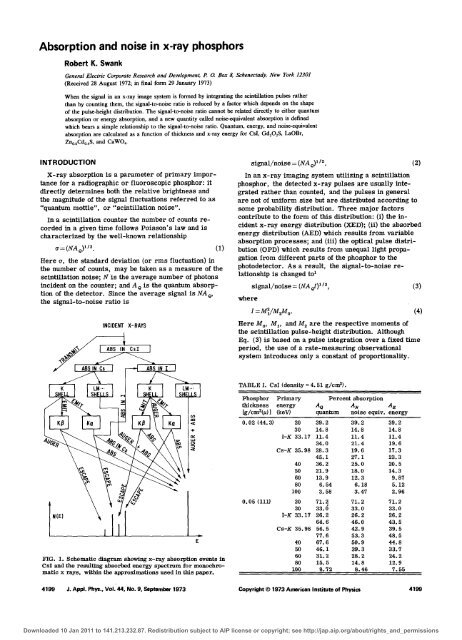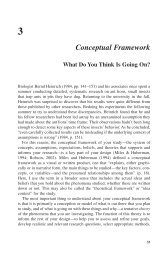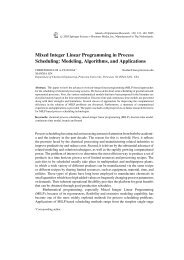Absorption and noise in x-ray phosphors
Absorption and noise in x-ray phosphors
Absorption and noise in x-ray phosphors
Create successful ePaper yourself
Turn your PDF publications into a flip-book with our unique Google optimized e-Paper software.
<strong>Absorption</strong> <strong>and</strong> <strong>noise</strong> <strong>in</strong> x-<strong>ray</strong> <strong>phosphors</strong><br />
Robert K. Swank<br />
General Electric Corporate Research <strong>and</strong> Development. P. O. Box 8. Schenectady. New York 12301<br />
(Received 28 August 1972; <strong>in</strong> f<strong>in</strong>al form 29 January 1973)<br />
When the signal <strong>in</strong> an x-<strong>ray</strong> image system is formed by <strong>in</strong>tegrat<strong>in</strong>g the sc<strong>in</strong>tillation pulses rather<br />
than by count<strong>in</strong>g them, the signal-to-<strong>noise</strong> ratio is reduced by a factor which depends on the shape<br />
of the pUlse-height distribution. The signal-to-<strong>noise</strong> ratio cannot be related directly to either quantum<br />
absorption or energy absorption, <strong>and</strong> a new quantity called <strong>noise</strong>-equivalent absorption is def<strong>in</strong>ed<br />
which bears a simple relationship to the signal-to-<strong>noise</strong> ratio. Quantum. energy, <strong>and</strong> <strong>noise</strong>-equivalent<br />
absorption are calculated as a function of thickness <strong>and</strong> x-<strong>ray</strong> energy for CsI. Gd20 2S, LaOBr.<br />
ZIlo.6Cdo.4S, <strong>and</strong> CaWO •.<br />
INTRODUCTION<br />
X-<strong>ray</strong> absorption is a parameter of primary importance<br />
for a radiographic or fluoroscopic phosphor: it<br />
directly determ<strong>in</strong>es both the relative brightness <strong>and</strong><br />
the magnitude of the signal fluctuations referred to as<br />
"quantum mottle", or" sc<strong>in</strong>tillation <strong>noise</strong>".<br />
,<br />
In a sc<strong>in</strong>tillation counter the number of counts recorded<br />
<strong>in</strong> a given time follows Poisson's law <strong>and</strong> is<br />
characterized by the well-known relationship<br />
(J=(NA Q )1/2. (1)<br />
Here (J, the st<strong>and</strong>ard deviation (or rms fluctuation) <strong>in</strong><br />
the number of counts, may be taken as a measure of the<br />
sc<strong>in</strong>tillation nOise; Nis the average number of photons<br />
<strong>in</strong>cident on the counter; <strong>and</strong> A Q is the quantum absorption<br />
of the detector. S<strong>in</strong>ce the average signal is NA Q ,<br />
the signal-to-<strong>noise</strong> ratio is<br />
INCIDENT X-RAYS<br />
FIG.!. Schematic diagram show<strong>in</strong>g x-<strong>ray</strong> absorption events <strong>in</strong><br />
CsI <strong>and</strong> the result<strong>in</strong>g absorbed energy spectrum for monochromatic<br />
x <strong>ray</strong>s, with<strong>in</strong> the approximations used <strong>in</strong> this paper.<br />
4199 J. Appl. Phys., Vol. 44, No.9, September 1973<br />
E<br />
signal/<strong>noise</strong> = (NA Q)1 12 • (2)<br />
In an x-<strong>ray</strong> imag<strong>in</strong>g system utiliz<strong>in</strong>g a sc<strong>in</strong>tillation<br />
phosphor, the detected x-<strong>ray</strong> pulses are usually <strong>in</strong>tegrated<br />
rather than counted, <strong>and</strong> the pulses <strong>in</strong> general<br />
are not of uniform size but are distributed accord<strong>in</strong>g to<br />
some probability distribution. Three major factors<br />
contribute to the form of this distribution: (i) the <strong>in</strong>cident<br />
x-<strong>ray</strong> energy distribution (XED); (ii) the absorbed<br />
energy distribution (AED) which results from variable<br />
absorption processes; <strong>and</strong> (iii) the optical pulse distribution<br />
(OPD) which results from unequal light propagation<br />
from different parts of the phosphor to the<br />
photodetector. As a result, the signal-to-<strong>noise</strong> relationship<br />
is changed to l<br />
where<br />
signal/<strong>noise</strong> = (NA J)1/2, (3)<br />
Here Mo' Ml , <strong>and</strong> M2 are the respective moments of<br />
the sc<strong>in</strong>tillation pulse-height distribution. Although<br />
Eq. (3) is based on a pulse <strong>in</strong>tegration over a fixed time<br />
period, the use of a rate-measur<strong>in</strong>g observational<br />
system <strong>in</strong>troduces only a constant of proportionality.<br />
TABLE I. CsI (density = 4. 51 g/cm 3 ).<br />
Phosphor Primary Percent absorption<br />
thickness energy AQ AN AE<br />
[g/cm 2 (J.I)) (keV) quantum <strong>noise</strong> equiv. energy<br />
0.02 (44.3) 20 39.2 39.2 39.2<br />
30 14.8 14.8 14.8<br />
I-K 33.17 11.4 11.4 11.4<br />
34.0 21.4 19.6<br />
Cs-K 35.98 28.3 19.6 17.3<br />
45.1 27.1 23.3<br />
40 36.2 25.0 20.5<br />
50 21. 9 18.0 14.3<br />
60 13.9 12.3 9.87<br />
80 6.54 6.18 5.12<br />
100 3.58 3.47 2.96<br />
0.05 (111) 20 71. 2 71. 2 71. 2<br />
30 33.6 33.0 33.0<br />
I-K 33.17 26.2 26.2 26.2<br />
64.6 46.0 43.5<br />
Cs-K 35.98 56.5 42.9 39.5<br />
77.6 53.3 48.5<br />
40 67.6 50.9 44.8<br />
50 46.1 39.3 33.7<br />
60 31. 2 28.2 24.2<br />
80 15.5 14.8 12.9<br />
100 8.72 8.46 7.55<br />
Copyright © 1973 American Institute of Physics 4199<br />
Downloaded 10 Jan 2011 to 141.213.232.87. Redistribution subject to AIP license or copyright; see http://jap.aip.org/about/rights_<strong>and</strong>_permissions<br />
(4)
















